#marina baleen
Text
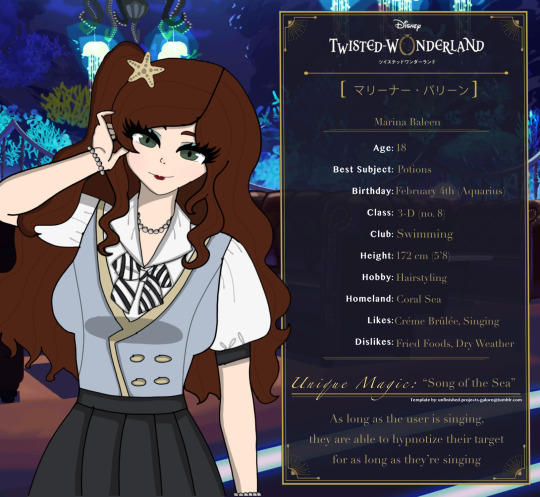
“What an interesting speciment we have here~”
Character Playlist / Character Inspirations
Full Name: Marina Lorelei Baleen
Nicknames: Mari (Sisters), Mademoiselle Sirène (Rook),
V/A: Kazumi Evans (EN), Miyuki Sawashiro (JP)
!Twisted from the Neverland Mermaids from Peter Pan!
Age: 18
Birthday: February 4th
Horoscope: Aquarius
Species: Merfolk (Siren variant)
Gender: Female
Pronouns: She/her
Height: 172 cm (or 5’8)
Hair Color: Burgundy
Eye Color: Sea Green
★。/|\。★
Homeland: Coral Sea
Family: Unnamed Father (deceased), Unnamed Mother, Five Unnamed Older Sisters
Dominant Hand: Right
Dormitory: Octavinelle
School Year: Third Year
Class: 3-D (No.8)
Best Class(es): Potions, Animal Language
Worst Class(es): Flying
★。/|\。★
Favorite Food(s): Créme Brûlée, Lobster, Salmon
Least Favorite Food(s): Fried Foods
Hobbies: Hairstyling, Lounging, Trying on Jewelry
Dislike(s): Dry Weather, Bad Hair Days, Molly Primrose
Talent(s): Singing, Self Care, Manipulation
Sexuality: Bisexual
★。/|\。★
Personality: Marina is the epitome of a classic siren, alluring but vicious! On the surface, Marina seems to be a vain and lazy young lady but on the inside, there’s a cunning and calculated side she has locked away inside. Marina is also just a gal who wants to have a good time! On the inside however, Marina can be quite kind and lovely to those she likes, though immediately switching back to her vicious side if someone she doesn’t like barges in. Marina can be a flirt too but if the flirting is genuine or just an act is unknown…
★。/|\。★
Mild TW for reference of Parental Death
Backstory: Marina comes from a family of merfolk living in the Coral Sea. Her family runs a perfumery business under the sea that Marina and her older sister help out at. She was often babied by her sisters due to being the youngest. Marina was very close with her father and was terribly saddened at his passing. In her family, singing was seen as a very important life skill and as such, Marina cultivated her singing voice along with her siblings. Later on, Marina was accepted to NRC of which her sisters and father were alumni of. She traveled onto land and was sorted into Octavinelle.
★。/|\。★
Trivia!
Marina sometimes falls asleep in her classes but still has high grades
The pearl necklace and bracelets she wears were a gift from her father!
At First, Marina was a bit hostile to humans but has since then gotten used to them
To those she’s close with, Marina has a habit of doing their hair for them!
Marina’s merform is reminiscent of a classic mermaid but much more fishy
#marina baleen#my art!#twisted wonderland#twst#octavinelle#octavinelle oc#twisted wonderland oc#twst oc#disney twst#disney twisted wonderland
25 notes
·
View notes
Note
Well Howdy Nette! Don’t mind me dropping in for some good ol’ fashioned interactions!
I was wondering what Joker and Lorne think of their dormmates Molly and Marina!
Also finding it funny that Aimée and Hiro is Aphrodite and Kermit, reminds me of Jessica Rabbit and Rodger rabbit
Hello hello! I'm happy to meet your Peter Pan cast-inspired cutiepies; they're both adorable.
Joker's glad to have Molly around; she seems like she'd be a stabilizing presence within the occasional chaos of Heartslabyul. She probably also asks her to come hang out with the knitting and crochet club ("Needlepoint totally counts, you know! We're not gonna be snooty about fiber arts distinctions."), and since they're both partial to wearing bows, they may end up exchanging ribbons sometimes just to have a little extra variety. I could see Molly's know-it-all moments getting a little under Jo's skin (Riddle does sometimes too, for the same reasons) but overall, I think that they'd get along quite well.
Now Lorne, that poor wet himbo of a man, he won't know what to do with Marina. I have a feeling they end up working together at Mostro an awful lot, as entertainment. I can see them having amazing stage chemistry together, and that their voices would work beautifully against each other. But Lorne is not a clever man. He'd be no match for Marina's wit, and he might end up being taken advantage of because of that. Sorry, Marina, he's a dumbass, but at least he's pretty and plays piano well.
~~I picked Aimée partially for the club they had in common and partially because the visual contrast between her and Hiro was so striking!! If I were to assign her a Muppet, she would absolutely match up to the glamour and beauty of a certain Miss Piggy, wouldn't you say?~~
6 notes
·
View notes
Text
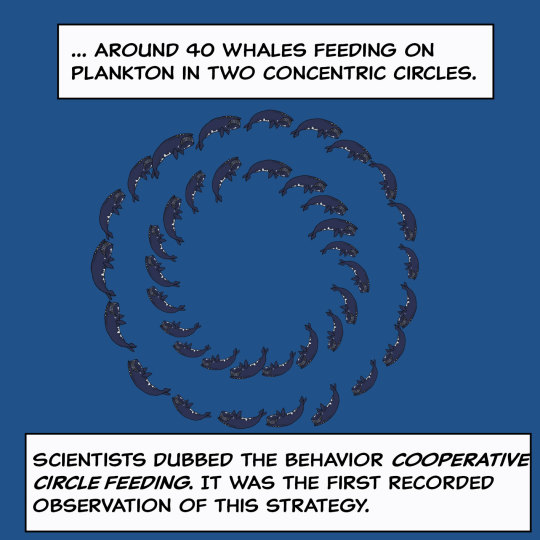
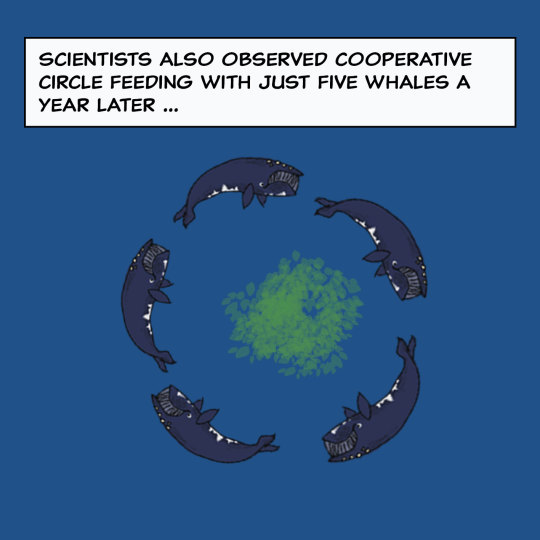
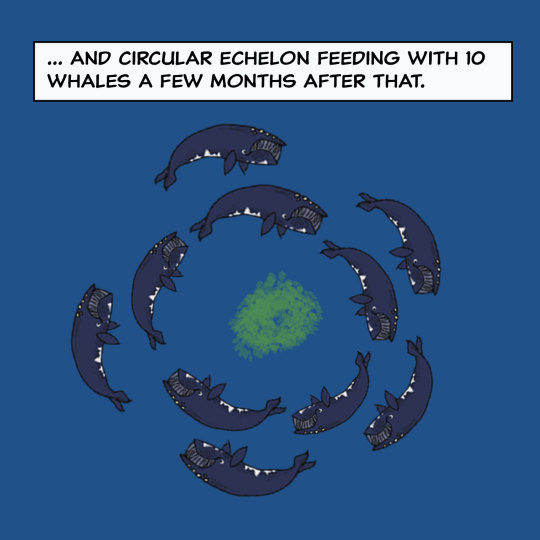
a few years ago, researchers from CESIMAR, a marine research center in Argentina, happened upon a never-before-seen behavior while studying southern right whales and ship traffic, and recently published their findings
DOI:10.1578/AM.49.1.2023.1
art by Marina Wang
#whales#marina wang#scientific illustration#eubalaena australis#argentina#cooperative feeding strategies#right whales#baleen whales#plankton#cesimar#maría belén argüelles#carla fiorito#mariano coscarella#ana fazio#marcelo bertellotti#bahia nueva#image quality should be unborked now#maybe
80 notes
·
View notes
Text
some district 4 name ideas : bay , marlin , pontus , delta , gully , marina , calliste , delphin , caspian , corelle , cora , davey , rhode , scylla , urchin , banks , ripetide , isla , thetis , triton , galiot , heron , tiller , birney , wade , gannet , albatross , petrel , laguna , sturgeon , dory , bellast , dover , undine , skipper , darya , maris , ronan , rilian , baleen , galleon , gill , herring , noah , jonah , adrian , arno , barbeau , birney , hurley , pike , beverly , tarni , winslet , tyde , marilla , nerine , yarrow , kenn , marsh , ren , trent.
#i had this list on my old blog but i’ve added to it#water and fishing themed names for all your oc and npc needs lol
21 notes
·
View notes
Text

Lolita the Killer Whale To Be Freed
A Love That Dare Not Spout Its Name
Oh Lolita. Light of my life, behemoth of my loins. My sin, my soul.
Mangled through the loudspeaker system of Whaleworld, she was Lo-lee-da. She was Lola at the feeding trough, attended by burly Neds and Nicks who spooned kelp muscularly into her jaws.
But in my telephoto lens and later at night in my cerebellum, she was always Lolita.
Did she have a precursor? Yes indeed – may I introduce a certain Willy of Wallyworld for whom I had unrequited teenage “hots” for five anguished years. If not for Willy, I might not have been as susceptible to Lolita’s shimmery flanks and louche blowhole. Willy set up the longing; Lolita swam into the trap.
How did we do it? How did we evade the aquarium patrols for so long? Well, I happened to have a device called a motorboat – I spent many an illusory hour zipping mindlessly around the marina even as the guards stared me down with their gargantuan, phallic binoculars. As if I cared one millicentime for the local brats – they could flash their brown limbs all they wanted, I was only interested in my 4,000-ton darling surging erotically in the depths.
And Lolita was there, to be had. Ladies and gentlemen of the jury, if I got close and shot tranquilizer into her with a borrowed dart gun (doctor, garage) I could sometimes access a segment of her tenebrous, black-glowing quiddity. And clinging awkwardly to her damply rubberish hide, I’d enjoy myself (as His Honor put it later) for a few precious seconds until some primitive survival reflex kicked in and she dove, my unpredictable darling, at a violently sharp angle into black depths, dislodging me to fight my way back to the surface.
This got wearying, I don’t deny. I’d have to locate my boat and swim often a great distance to retrieve it, my mood not improved by Lolita surfacing with showy lunges and siphon spurts – activity designed to delight shallow Bobs and Bettys on the tour boats, which wounded my feelings after so recent an intimacy.
I leaf through these memories with both joy and misery, for Lolita gave me much of both. And I return to a question I often put to myself: Why could I only love whales? Was it the adolescent obsession with Willy, which glittered in memory though it took place exclusively in movie theaters, that set my compass eternally on 10-ton mammalian love objects? I’ve never quite figured it out and I refuse callow counseling about “appropriateness” – that signpost of mediocrity wherever it alights!
But I’m tired of explaining myself, which I’ve done ad infinitum from both this jail cell and the hospital where I’m featured in silly classes on interspecies perversity. What I want to convey today is my fond regret on learning Lolita is being “freed” – she will be taken to her original home in the Pacific Northwest, where I always sensed she’d end up, being a very broad sort of creature in the end. I can’t say I’ll exactly miss her. You see, alas, my passion for my ethereal cetacean ebbed since she reached 50 whale years. With age has come a dimming of her glorious, shimmery snout – it’s now merely functional – and even her tail only waves in desultory nods where once it swept about like the seraphims’ sashes in Botticelli’s Venus. As for her hide, it barely gleams, except in my memory, of course.
I console myself with these lines, inscribed forever on my soul:
Oh Lolita, you are my girl – who cares about size or phylum?
Are you Beluga, Orca or Baleen? What matter, my sweet Leviathan?

2 notes
·
View notes
Text
La Célula, Diversidad Celular
Las células, llevan a cabo los procesos que tienen lugar en los organismos vivos. Las células, además, adoptan formas, tamaños y expresan gran cantidad de genes diferentes, dando origen a una gran diversidad.
Incluso a pesar de que el material genético de dos células de un mismo organismo es idéntico, las células pueden llevar a cabo múltiples funciones e implicar grandes consecuencias.
Los eritrocitos o glóbulos rojos, son un grupo muy especializado de células. Representan alrededor del 45% de todas las células de la sangre, y son las encargadas de transportar oxígeno desde los pulmones, donde se produce el intercambio gaseoso, hasta todos los otros tejidos del organismo. Para cumplir esta tan importante función, los eritrocitos presentan diversas modificaciones en su morfología. Una de las modificaciones más importantes, es que los eritrocitos no presentan núcleo. Al no tener núcleo no pueden sintetizar nuevas proteínas, por lo que la vida de los eritrocitos está bastante limitada, alrededor de 120 días.

Las neuronas son otro grupo hiper especializado de células, que se encuentran exclusivamente en el sistema nervioso. En gran parte son las responsables de transformar los estímulos externos, es decir, los estímulos del ambiente, en señales eléctricas que luego son interpretadas por el cerebro y traducidas a cambios tanto en la fisiología como en el comportamiento.

¿Cómo son capaces las neuronas de generar impulsos eléctricos? Esto es gracias al intercambio de iones, principalmente sodio y potasio, entre el interior y el exterior de la neurona.
Este intercambio genera una diferencia en las concentraciones de estos iones entre el interior de la neurona y el medio extracelular; y debido a que los iones presentan una carga eléctrica, la diferencia de concentraciones entre el interior y el exterior se traduce en una diferencia de cargas eléctricas. A esto se le llama un gradiente electroquímico. Cuando este gradiente es lo suficientemente grande, se genera en la neurona un Potencial de Acción.
El potencial de acción generado en una neurona es propagado de neurona en neurona a través de la sinapsis, un acercamiento entre dos neuronas que permite la comunicación entre ellas. La comunicación mediante sinapsis entre muchas neuronas es lo que genera las llamadas redes neuronales. Según las más recientes estimaciones, existen aproximadamente 120 mil millones de neuronas en un cerebro humano adulto. Cada una de estas neuronas puede tener sinapsis con otras 10.000 neuronas. Con estos números, la complejidad de interacciones que se puede dar entre neuronas es gigantesca.
Debido al pequeño tamaño que tienen las neuronas, en la escala de micrómetros, dificulta su estudio. Es por esto que una de las neuronas más estudiadas fue la neurona de las jibias. ¿Qué las hace tan especiales? Los axones de estas neuronas, es decir, la parte de la célula donde se propaga el impulso nervioso, alcanza el tamaño de un fideo. Esto hace sumamente fácil su manipulación para la investigación.

La abundancia de este animal en el mar chileno, permitió que durante décadas los descubrimientos más importantes de la neurobiología mundial tuvieron lugar en el laboratorio de Montemar de la Universidad de Chile, en Viña del Mar. Parte importante de lo que conocemos acerca de cómo funcionan los impulsos nerviosos; que transmiten las sensaciones, recuerdos o pensamientos, fueron hechos en este lugar gracias al axón gigante de jibia.

Un organismo vivo puede estar conformado por millones o una única célula. Los organismos unicelulares, es decir, aquellos organismos que comprenden una única célula, pueden resultar de gran importancia y de insospechado impacto. Por ejemplo, cuando se trata de microorganismos patógenos, que causan enfermedades, o como en el caso de la marea roja u otras algas nocivas; su presencia pueden tener importantes consecuencias.
Entre abril y mayo de 2016 un florecimiento nocivo de Alexandrium (un alga dinoflagelada), se extendió desde el mar de Chiloé al Océano Pacífico por cerca de 400 kilómetros, causando la muerte masiva de aves marinas y moluscos. Esto tuvo importantes consecuencias económicas y sociales en la región afectada.
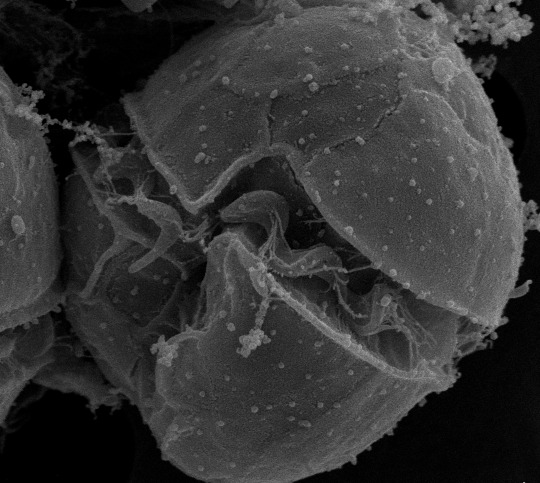
Otro microorganismo marino que puede llegar a tener consecuencias fatales, es el Vibrio parahaemolyticus, que a diferencia de Alexandrium, Vibrio es una bacteria. Causante de cuadros de diarrea aguda, recientemente se ha detectado que su incidencia ha aumentado en frecuencia y en expansión, en particular en la X región, donde se produce el 90% de los mariscos que se consumen en Chile.
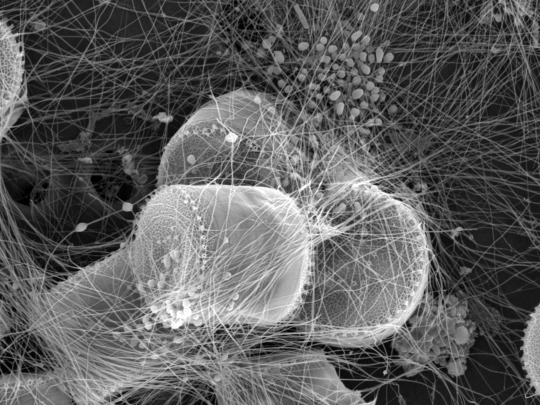
Se ha detectado que los varamientos masivos de algunos cetáceos como el que tuvo lugar en Aysén en 2015, donde se hallaron más de 300 ballenas varadas, pudieron ser causados por florecimientos masivos de algas nocivas.
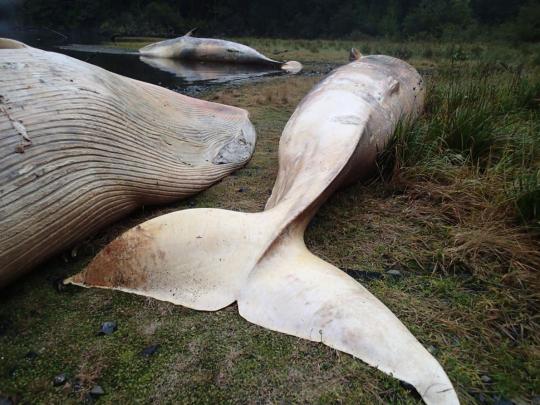
El registro fósil como el de Cerro Ballena, en la región de Atacama, demuestran que este no es sólo un fenómeno reciente, sino que ha ocurrido reiteradamente en el pasado, desde a lo menos 8 millones de años.

¿entonces cómo las células pueden ser tan diferentes? ¿cómo pueden transmitir un impulso eléctrico? ¿o comportarse como un patógeno, siendo letales e incluso una amenaza para otros organismos?
Todas las células almacenan la información necesaria para generar todos los procesos y partes que las componen, en una macromolécula, el ácido desoxirribonucleico, conocido como ADN. Esta molécula codifica la información mediante la alternancia de sus cuatro nucleótidos (Adenina, Citocina, Timina y Guanina), que se ensamblan bajo reglas específicas (Adenina se une a Timina, y Citosina a Guanina). Como un código, la secuencia de los nucleótidos es leída por una maquinaria proteica que transcribe, en otra molécula de gran importancia, el ácido ribonucleico, o ARN. Los nucleótidos son traducidos, En grupo de a tres, que llamamos codones, a la secuencia de aminoácidos que conforman las proteínas. Los aminoacidos al igual que bloques de construcción LEGO, ensamblan la proteína, otorgandole las propiedades con las cuales las proteínas llevan a cabo prácticamente todas las funciones de la célula.
Referencias:
Rutecki, P.A.1992. Neuronal excitability: voltage dependent currents and synaptic transmission. JCNP, 9(2): 192-211
The Great Squid Hunt. 2008. Nature 454: 934-936
Borges, R., Viveros, O.H., Latorre, R. 2006. Save the Lab in Montemar, Chile. Science 311:1866
Rojas, E., Luxoro, M. 1963. Micro-injection of Trypsin into Axons of Squid. Nature 199:78-79
Tasaki, I., Luxoro, M. 1964. Intracellular Perfusion of Chilean Giant Squid Axons. Science 145:1313-1315
Tasaki, I., Luxoro, M., Ruarte, A. 1965. Electrophysiological Studies of Chilean Squid Axons under Internal Perfusion with Sodium-Rich Media. Science 150:809-901
Cabello, F.C., Godfried, H.P. 2016. Florecimientos de algas nocivas (FANs), ecosistemas marinos y la salud humana en la Patagonia Chilena. Rev Chilena Infectol. 33 (5): 559-560
Hernández G, C., Ulloa P., J., Vergara O., J.A., Espejo T., R., Cabello C., F. 2005. Infecciones por Vibrio parahaemolyticus e intoxicaciones por algas: problemas emergentes de salud pública en Chile. Rev Méd Chile 133: 1081-1088
Häussermann, V., Gutstein, C. S., Bedington, M., Cassis, D., Olavarria, C. , Dale, A.C., Valenzuela-Toro, A.M., Perez-Alvarez, M.J., Sepúlveda H.H., McConnell, K.M., Horwitz F.E., Försterra G. 2017. Largest baleen whale mass mortality during strong El Niño event is likely related to harmful toxic algal bloom PeerJ 5:e3123 https://doi.org/10.7717/peerj.3123
http://news.nationalgeographic.com/2015/11/151120-worlds-largest-whale-stranding-sei-chile-animals/
http://www.bbc.com/mundo/noticias/2016/05/160503_chile_marea_roja_catastrofe_alerta_sanitaria_ab
http://cerroballena.si.edu
#biología#biología celular#marea roja#glóbulos rojos#eritrocitos#neuronas#jibia#axones#montemar#laboratorio de montemar#alexandrium#vibrio#Chile#ADN#ARN#aminoacidos#adenina#citosina#guanina#timina#uracilo#codones#transcripción#traducción
1 note
·
View note
Text
Physics-defying ocean critter’s ‘propeller’ caught on camera
Researchers have captured on video the physics-defying trick a tiny crustacean called Acartia uses to move through water.
Walk along an Oregon beach and scoop up standing water left by the tide. Inside it you’ll likely see tiny flecks moving at high speed. They probably are copepods, abundant aquatic crustaceans, barely two millimeters long, that are an integral part of the ocean’s food web.
Researchers recently scooped water from Charleston Marina to gather a bunch of these tiny sea creatures and study them under a microscope and with high-speed videography.
George von Dassow and Richard Emlet of the Oregon Institute of Marine Biology at the University of Oregon were especially curious because former graduate student Ella Lamont had made a remarkable discovery about the swimming legs of barnacle larvae.
The marine biologists wanted to know if copepods, the dominant animals in ocean plankton, have a similar biological mechanism for acceleration.
In a paper in Biological Bulletin, they documented that, at least for the common copepod species Acartia, their suspicion was correct.
The physics-defying Acartia
“These incredibly abundant and ecologically-important marine animals have a neat trick to beat the physics of their environment,” says von Dassow.
“They’ve made a paddle out of a lightweight, elastic material that nearly isn’t there, but which likely behaves almost like a solid and allows them to get going fast enough that they break away from the water’s viscosity.”
Copepods form, as do barnacles, a short-lived fan-like structure by linking extracellular filaments of their cuticle—much like fingernails, hair, or feathers—to create paddles on their swimming legs. The paddles are open meshworks of exoskeleton that open and close in less than 10 milliseconds with each swimming stroke. A sweeping, arc-like movement of these paddles, captured on video, enables bursts of speed that defy the physics and help escape danger.
“When we swim, we barely notice water’s viscosity,” von Dassow says. “We notice that it’s heavy and hard to push around. To small organisms, however, water is very sticky, and, to them, water feels about like it would to us if we had to swim in Karo syrup.”
In effect, the limbs in copepods become much larger and more powerful than is possible if they relied on living tissue, he says. The transition is similar, he adds, to how birds mastered the air by making large vaned feathers.
The earlier discovery in barnacles by Lamont and her mentor, Emlet, drew little interest from publishers when they initially submitted her documentation. Eventually, Biological Bulletin published the work in 2018. That research focused on the cross-linked swimming legs of cyprids, the last-stage larva of barnacles.
Lamont, who is now at the University of Washington where she is a research associate in the School of Dentistry, says she was happy to hear that Emlet and von Dassow used her findings as a catalyst for additional research.
“Barnacles are one of my favorite animals, and I wanted to study them for my master’s work,” she says. “Richard suggested that I could do something along the lines of describing how cyprids swim. There had been a lot of work on cyprids and how they cement themselves to things, such as boats, but there was almost no description of cyprid swimming in the literature.”
She spent hours with Emlet’s high-speed camera trying to capture cyprid swimming. In doing so, she captured how quickly they could move and what their appendages were doing.
“Cyprids are positively photoactive, so I basically had to sit in the dark for several minutes, then turn on the lights and hope that the cyprid would swim in front of the camera,” she recalls.
‘Curiosity-driven research’
Researchers have also extensively studied copepods. In 2003, scientists at the University of Texas Marine Science Institute in Port Aransas used high-speed videography to document a burst of speed some 10 times higher than the crustaceans’ normal movement, but that work did not capture how it was accomplished.
“Our findings in copepods is really an extension of Ella’s discovery,” von Dassow says. “It is basic natural-history, curiosity-driven research, the kind of discovery science that marine labs are here for.”
The project was tricky, he says. Copepods are delicate and difficult to handle without causing physical damage to them.
“Many of our recordings were made by putting a small number of copepods in a small petri dish with a glass coverslip for a bottom,” he says. “They tend to sit still for a while if nothing disturbs them, but they disturb each other. When I put a half-dozen in a dish they played musical chairs, and I was able to catch them on camera as they swam across the field of view.”
That, he says, happens quickly, to the tune of 10 milliseconds, and recording it required a video camera that can capture 8,000 frames per second. By comparison, normal video runs at 30 frames per second, or 33 milliseconds between frames, which is faster than humans can see but much slower than the copepods’ bursts of speed. Aiming the microscope isn’t possible, he says: one just has to wait for the animals to cross the field of view.
“Once in maybe 10 or 100 tries, I got a glimpse of something worth seeing,” von Dassow says. “The key sequences we showed in our paper that caught the mesh clearly were literally one-in-a-thousand lucky grabs.”
The new findings apply to both adults and to pre-adult molting stages of Acartia, which have an overall life span of about a month, like many insects, he says.
“There are important ecological questions raised by this work,” von Dassow says. “Everything from fellow crustaceans to baleen whales like to eat these animals. They have this rapid escape response for some reason. It’s energetically expensive and they probably don’t just do it for fun, so it is likely important to their survival.”
On the coast, copepods are both hard to see and hard to avoid. Certain species are abundant in splash pools on the coast, where beachcombers are most likely to notice them, von Dassow says.
“Without a plankton net to concentrate them, there might not be more than a few in a quart, but they’d be there,” he says.
“Over the course of many open houses, I’ve found that there are two kinds of people in the world: those who respond to this news by saying, ‘really, the water’s full of beautiful things like that?’ and those who say, ‘you mean those are getting in my shorts when I go swimming?'”
Source: University of Oregon
The post Physics-defying ocean critter’s ‘propeller’ caught on camera appeared first on Futurity.
Physics-defying ocean critter’s ‘propeller’ caught on camera published first on https://triviaqaweb.weebly.com/
0 notes
Link
Everett
Everett AM
We hosted Queen Anne Elementary on the boat this morning, and had amazing energy on board from both kids and whales alike! The trip started out with an eerie, yet beautiful, fog hanging over Possession Sound. Undaunted by the less than ideal spotting conditions, Captain Tyler found three gray whales in no time, making for a great start to the day. Amongst the grays were Earhart #22 and Patch #49, as evident by Patch’s distinct birthmark and Earhart’s stunningly beautiful fluke. We spent some time with these whales as they lounged at the surface, seeming quite content to hang along side us. This alone would have been a lovely trip, but the day just kept getting better. We’d heard a rumor that there were orca whales to the south, so we cruised in that direction. Sure enough, just outside of Kingston, the T65A family was working on a kill! To be able to see hunting in action, and the following tail slaps and spyhops was a true treat. Given that the class had been studying whales, it was so fun to be able to show them both baleen and toothed whales up close, and to add to their knowledge of these two species. Thanks for joining us Queen Anne Elementary!
Everett PM
We may have been fogged in this morning, but it was all sunshine and calm seas this afternoon. We could not have asked for a more perfect trip to end the crew’s season here in Everett. As we were leaving the marina, we watched as daddy osprey took on several bald eagles that were hanging out too close to mama and the nest. From there it wasn’t long before an amazingly observant passenger found us the first whale of the day. It was a gray whale, miles away, and unfortunately it was deep into the delta in shallow water where we could not follow. So, we continued the search. It wasn’t long before Captain Tyler found us two more gray whales, and these two were in deeper water. It turned out to be Earhart #22 and Patch #49. They were socializing, swimming side by side throughout the Sound. Earhart showed off her gorgeous fluke, while Patch gave big arches of the back with no follow up tail, as he is prone to do. While we were watching the gray whales, our naturalist spotted something unusual off in the distance. It looked like splashing from where we were at the northern end of the delta, but upon closer inspection she discovered it was none-other than the T65As in hot pursuit of prey! To say the crew was excited would be an understatement. This pod of Bigg’s orca whales were practically at the entrance of Naval Station Everett, and they were making quite the scene. In all of the excitement, we nearly missed Patch showing off his fluke right next to the boat! A fitting send-off for the crew’s last encounter with Patch this season. We made our way over to where the orca were now milling, blood in the water. It was quite the site to behold, Mom (T65A) teaching her one year old (T65A6) how to hunt, while the siblings worked together to coral their prey. The follow-up celebration was all pec-slaps and spyhops, the little calf doing several dramatic head-stands as well. The family continued up the delta, keeping clear of the gray whales that seemed to be sticking to the shallowest areas possible. Were they aware of the predators nearby? It certainly seemed that way, because when we tried to relocate other gray whales we’d seen off on the horizon earlier in the trip, they were nowhere to be found. So, we met back up with the orcas in Port Susan, before cruising back to Everett, spying actively feeding gray whales deep in the delta along the way.
- Sam
0 notes
Text
Twisted Wonderland Oc Masterlist
Ramshackle
Ellis Clawthorne (The Ramshackle Prefect)
Heartslabuyl
Astrid Aneira (Twisted from Anna)
Molly Primrose (Twisted from Wendy Darling)
Savanaclaw
Artemis Woodman (Twisted from Man)
Octanivelle
Fabian Nacht (Twisted from Flynn Rider)
Marina Baleen (Twisted from the Neverland Mermaids)
Scarabia
there seems to be nothing here…
Pomfiore
Stella Vega (Twisted from the Wishing Star)
Odette Cygnet (Twisted from Duchess Swan)
Ignihyde
Aimée Amore (Twisted from Aphrodite)
Diasomnia
Victoria Le Fay (Twisted from the Three Fairies)
Ivy Villosa (Twisted from Rosetta)
Gwendolyn Schnee (Twisted from Periwinkle)
Terrovania (belongs to @/terrovaniadorm/@/hallowed-delights)
Alice Darius (Twisted from Lady Dimitrescu)
Lilith Winchester (Twisted from Lucy Westenra)
Lizzie Shelley (Twisted from Lisa Swallows)
RSA
Sanwaii (belongs to @/twsted-princess)
Hoshiko Itsuki (Twisted from Lala/Little Twin Stars)
Hikari Itsuki (Twisted from Kiki/Little Twin Stars)
Fableheart (belongs to @/jasdiary)
Reina Carrion (Twisted from Mira Shards/The Evil Queen) (coming soon...)
#my ocs!!!!#ellis clawthorne#victoria le fay#twisted wonderland#twst#ivy villosa#artemis woodman#aimée amore#gwendoyln schnee#fabian nacht#hoshiko itsuki#hikari itsuki#alice darius#astrid aneira#stella vega#odette cygnet#lilith winchester#reina carrion#molly primrose#marina baleen#masterlist#lizzie shelley
10 notes
·
View notes
Text
Guess who decided to make another oc! This gal!
This time it’s actually two (or three if you count another one) ocs! A little sneak peak on whom they’re twisted from!
First we have miss Molly Primrose
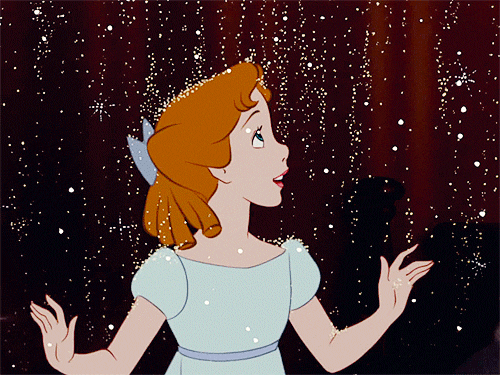
And next we have Marina Baleen!
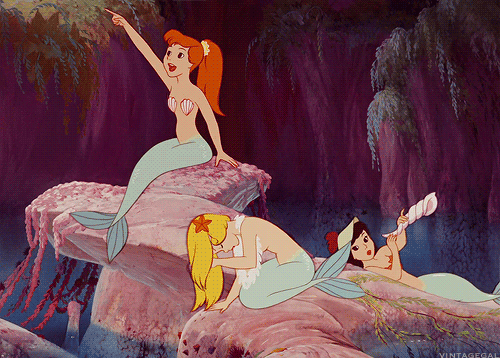
And Finally Reinette (Reina) Carrion

#Reina is for Fableheart of course!#they’ll all be released one day!#one day....#molly primrose#marina baleen#reinette carrion#my ocs!!!
10 notes
·
View notes
Text
I decided to make a list of TWST events and which ocs participated in them!
Notes: Ellis participates in almost all of the events as she is the mc/yuu of the story! RSA ocs did not participate in these events
Bean Day - Ellis, Artemis, Alice
Fairy Gala - Ellis, Ivy, Gwen, Odette
Ghost Marriage - Ellis, Victoria, Aimée
Wish Upon a Star - Stella
Scary Monsters/Halloween - Everyone
Vargas Camp - Ellis, Artemis, Molly
Al’ab Nariya - Ellis, Marina, Ivy
Harveston - Ellis, Astrid, Gwen
Port Fest - Ellis, Fabian, Marina, Molly
Glorious Masquerade - Ellis, Victoria, Ivy, Aimée, Alice, Stella, Marina, Lizzie
Tamashina Mina - Ellis, Artemis, Aimée
White Rabbit Festival - Ellis, Molly, Astrid, Lizzie
Midsummer Sea and Spaceship - Ellis, Fabian, Marina, Lilith
Playful Land - Artemis, Gwen, Fabian, Astrid, Odette, Lilith, Molly
Tapis Rouge - Ellis, Ivy, Aimée, Fabian
#ellis clawthorne#victoria le fay#twisted wonderland#twst#my ocs!!!!#ivy villosa#artemis woodman#aimée amore#gwendolyn schnee#alice darius#fabian nacht#astrid aneira#stella vega#odette cygnet#lilith winchester#marina baleen#molly primrose#lizzie shelley
2 notes
·
View notes
Note
📻 + Odette and Marina!
I feel like this song is much more explanatory on why it’s in Odette’s playlist! Obviously, Odette is very much inspired by Swan Lake and I wanted to show this by adding many songs from the ballet into her playlist!
One of the main reasons I have Marina her name is because I’m a big fan of the music artist MARINA! This song really does reflect her personality along with wants and desires with the lyrics “I know I’ve got a big ego/I really don’t know why it’s such a big deal, though” and the lyrics “All I ever wanted was the world/I can’t help that I need it all”
2 notes
·
View notes
Text
Character Inspirations pt. 2♡
These are the character inspirations for my fandorm ocs and canon dorm ocs that couldn’t fit on the original post!
Enjoy!

Hoshiko Itsuki’s Inspirations
Kiki (Kiki’s Delivery Service)
Hu Tao (Genshin Impact)
Mako Mankanshoku (Kill La Kill)
Lala (Sanrio)
Yoimiya (Genshin Impact)

Hikari Itsuki’s Inspirations
Wanderer (Genshin Impact)
Haru Nanase (Free! Iwatobi Swim Club)
Kiki (Sanrio)
Takashi Morinozuka (Ouran High-School Host Club)
Saiki Kusuo (The Disastrous Life of Saiki K)
Shikanoin Heizou (Genshin Impact)

Alice Darius’s Inspirations
Carmilla (Carmilla)
Morticia Addams (The Addams Family)
Carmilla (Castlevania)
Alcina Dimitrescu (Resident Evil:Village)
Nadja of Antipaxos (What We Do in the Shadows)
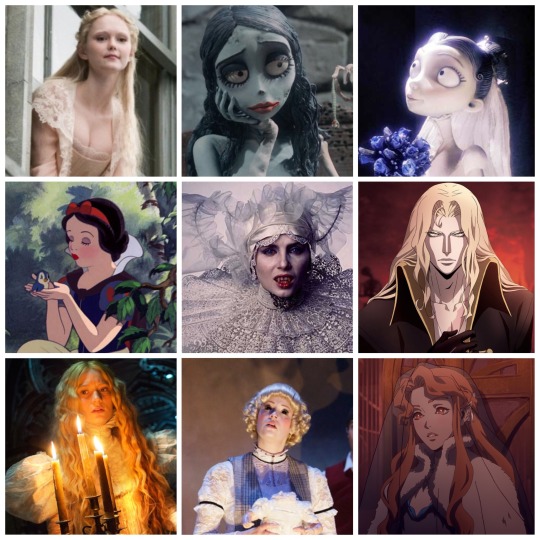
Lilith Winchester’s Inspirations
Johanna Barker (Sweeny Todd: The Demon Barber of Fleet Street)
Emily (Corpse Bride)
Victoria Everglot (Corpse Bride)
Snow White (Snow White and the Seven Dwarves)
Lucy Westenra (Dracula novel & Bram Stoker’s Dracula)
Alucard/Adrien Trepes (Castlevania)
Edith Cushing (Crimson Peak)
Jane Doe/Penny Lamb (Ride the Cyclone)
Lenore (Castlevania)

Molly Primrose’s Inspirations
Liesel Von Trapp (Sound of Music)
Wendy Darling (Peter Pan)
Molly Aster (Peter and the Starcatcher)
Ocean O’Connell Rosenberg (Ride the Cyclone)

Marina Baleen’s Inspirations
Vanessa/Ursula (The Little Mermaid)
Adagio Dazzle (My Little Pony Equestria Girls: Rainbow Rocks)
Jessica Rabbit (Who Framed Rodger Rabbit)
The Neverland Mermaids (Peter Pan)
Cala Maria (The Cuphead Show!)
Regina George (Mean Girls)
Ariel (The Little Mermaid)

Lizzie Shelly’s Inspirations
Veronica Sawyer (Heathers)
Wednesday Addams (The Addams Family)
Allison Reynolds (The Breakfast Club)
Lisa Swallows (Lisa Frankenstein)
Lydia Deetz (Beetlejuice)
#hoshiko itsuki#alice darius#hikari itsuki#lilith winchester#my ocs!!!#marina baleen#molly primrose#lizzie shelley
3 notes
·
View notes
Note
Greetings from the random oc questions tabby kitten! 💙
Which OC of yours does this song/artist/genre/decade/vibe remind you of and why?
Your song is “You're So Vain" by Carly Simon
Well this is an interesting question!
I’d say that the oc that fit the song would have to be Marina!
She’s my most vain oc by far! She cares much about herself than others (a trait she has to unlearn soon!) and it wouldn’t be too far fetched to have someone singing a song about how vain she is!
0 notes
Link
Anacortes • La Conner • Port Angeles
Anacortes
We had a great day on the water today with some amazing wildlife!!! We headed out of Cap Sante marina and hugged the coasts of Fidalgo island and Burrows island as we headed toward whales that were with the Island Explorer 4. We made a stop at Williamson rocks and found a bunch of harbor seals and a big group of cormorants. We continued south from there cruising through Deception Pass and passed Ben Ure island. We joined the T49A’s at Poipis point and showed up right as lunch was served. They took down their prey quickly and then began to play around. We had an amazing encounter with the orcas and they were in a very playful mood after they ate. T49A1 and one of his younger siblings even swam right under the boat at one point which was quite a sight to see. We continued to watch the orcas as they proceeded out of Deception pass and even spotted a Bald eagle hanging out on Whidbey Island. The orcas began to hunt again around Deception island. Which was pretty intense to watch but great to see these majestic giants thriving in our waters. After waving goodbye to the orcas we headed up to Rosario strait and saw a Steller sea lion on a navigational buoy. From there we stopped at Bird rocks and saw a few more Steller sea lions and harbor seals. It was a perfect trip with lots of great action and beautiful views.
-Tyson
La Conner
Well, it wasn’t too hard to find whales today, seeing as they met us at Deception Pass. We’d taken the southern route through the Swinomish Slough this morning, finding double-crested cormorants, bald eagles, great blue herons, Caspian terns, belted kingfishers, and plenty of harbor seals along the way. We were just about to round the corner at Hoypus Point when we came across the T49As. We weren’t even an hour into our journey; what a find! We cruised with them as they made their way against the extreme currents back towards Deception Pass. Seeing them porpoise through the brilliant turquoise water, the backdrop lined with evergreens and the fall-colored deciduous trees was spectacular. They picked off a harbor seals just outside of Deception Pass and passed it between the family as the 5+ knot currents rushed around them. What a spectacular setting. We left them to continue their push through the Pass, and we set off in search of more marine life. We found it along the west side of San Juan. K pod was mingling with Pacific White Sided Dolphins! They were cruising alongside each other in search of fish, and from the looks of it, both dolphin species were successful in their hunt. What a sight! On the return trip home, we visited with a lone Steller sealion on one of the Lawson Reef Nav Markers, followed by one more visit with the T49As (they’d finally worked their way through the Pass). It was smooth sailing home, interrupted here and there by a few rain showers that had held off until that point.
-Sam
Port Angeles
We started our journey under cloudy skies passing lots of seabirds in the harbor. A few harbor seals were spotted in the water by Ediz hook as we entered the straits of Juan de Fuca. Traveling north we searched for whales but it wasn't until we were in Canadian waters did we find our first two whales. They were our big baleen whales, the humpbacks. They seemed to be traveling east together and getting good looks at their flukes we found we knew these two. Both Nike and Scratchy were putting on quite a show for us when Scratchy decided to throw a huge caudal peduncle throw or cartwheel. It was amazing to see the raw power. After a bit we heard there were transient orcas nearby so we headed over to see them. They were close to the shore looking for seals and we watched them search the kelp along the rocks seeing one lucky seal escape detection. We followed them all the way into Becher Bay as they traveled the length and depth of it in their search. At one point it looked like they may have caught something but they moved on quickly. We spent quite awhile with the T109A family and finally had to say goodbye. We turned east and checked out Race Rocks. There were harbor seals and Steller sea lions on ledges .There were an extremely large gathering of California sea lions and the barking was loud. One of the ecoguardians came out and was trying to shoo all the sea lions off the ramp as a boat was coming in and they were having none of it complaining loudly and being defiant. We spied Ollie the sea otter in a bed of kelp floating on his back looking a little sleepy. Many ooohs and aaahs ensued. We had to tear ourselves away to start the trek home just in time to have a few sprinkles at the dock.
-Lee
0 notes
Link
Anacortes - Port Angeles
Anacortes AM
After leaving Cap Sante Marina, we started our journey into Guemes Channel and over to Rosario Strait. Our first stop was at Belle Rock and Bird Rocks. We spotted an eagle on the channel marker as well as a bunch of harbor seals and two big male Steller sea lions. After that, we cruised over to Castle Island and Blind Island. There were two harbor seal pups and mom pairs on rocks, as well as a bald eagle perched in the trees right next to the boat. Our next stop was at our first whale of the day. A humpback whale was feeding at McArthur Bank. The whale was surfacing regularly and we were really fortunate to see it lunge feed at the surface. The next stop was to another humpback whale that was consistently showing tail right next to the boat when it dove down. After saying goodbye to the humpbacks, we cruised over to Smith and Minor island where we found two tufted puffins. On our way home, we made a surprise stop at Deception Pass Bridge before heading to port.
- Emma
Anacortes PM
Beautiful sunset cruise tonight with awesome whales. Our trip started out with a stop at Bird Rocks where a bunch of harbor seals were sun bathing on the beach. We then headed north through the San Juan Islands. We made another stop at Pea Pods to see more harbor seals and then journeyed into Canadian waters. A pod of orcas was spotted in the middle of the Strait of Georgia, off the coast of Point Roberts. There were about five individuals identified as a transient, or marine mammal eating, pod of orca, specifically the T46s. Four of the orcas were surfacing at the exact same time off the side of our boat with another larger male leading the way off our bow. After watching them for a while, we ventured back towards home with a quick cruise by Patos Island light house. The sun was setting the entire ride back which was beautiful.
- Emma
Port Angeles AM
A beautiful morning with lots of promise as we started our journey. A few harbor seals played in the water at Ediz Hook. Not even 2 miles out of Port Angeles we encountered our first whale. It was a humpback named BCZ0298 Split Fin. He was feeding in large circles. After awhile we continued on and found a few more humpbacks not far from each other. One was MMX0009 Frankenstein and after a few pec slaps , an unexpected breach and a cartwheel the two whales joined forces to feed together just Southeast of Race Rocks. We saw a few more blows in the distance as we watched this pair. We ambled over to Race Rocks and found some Harbor Seals and a large raft of Steller Sea Lions playing in the water.. Just south of Race Rocks we picked up another humpback named Scratchy before heading a little east to get a few last looks at Frankenstein and his unidentified friend as they were heading in the same direction that we had to go to get home. All in all what a great morning with tons of humpbacks.
- Lee
Port Angeles PM
Lots of tankers were moored in the harbor as we passed by getting some great looks at them. The Olympics looked like the clouds were breaking up and had some great cloud formations. We entered the Salish Sea and headed north. Our first whale was humpback whale that we had never seen before so it was pretty exciting. We followed this guy for awhile before spotting another humpback heading east who we identified as MMZ0004 Zephyr but he was heading away from an area we wanted to check so we said our goodbyes to him. Soon we were near race rocks so we took a peek at the wildlife in there and found lots of harbor seals and plenty of massive steller sealions all along the rocks. One California sea lion was hauled out. After going through race, we found another humpback but it was a long diver and gave us the slip. Our first whale was still in the vicinity so we went over to see him and it was good that we did because with the tide change he was actively lunge feeding. We stayed with him for as long as time would permit so we could enjoy his antics as he rolled on his side showing his pectoral fins and flukes. We had some great looks at the inside of his mouth and the baleen . We were all a little sad that we had to depart but what a time we had.
- Lee
0 notes